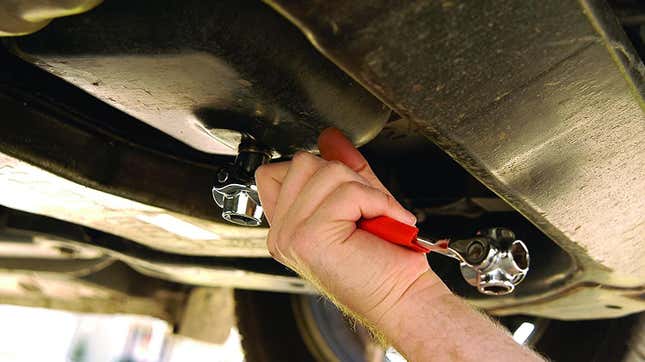
Thinking about changing your own oil? While I won’t teach you how to do that (you can find tutorials for your specific car on YouTube), let me help you make sure you know which tools and materials are needed ahead of time to get the job done.
While most repair shops across the United States are still open and deemed essential on a federal level, many people are avoiding leaving their homes for things like routine maintenance. I wouldn’t normally recommend changing your oil yourself. A lot could go wrong if you aren’t super careful and it isn’t always worth it at the end of the day. However, these aren’t typical times and you may want to try your hand at a project that, if done right, is simple and straightforward.
Drain Plug Wrench
You’ll need a wrench to remove the drain plug from the oil pan in order to drain the oil. Different vehicles have different drain plugs, but this one from Hopkins fits most vehicles. This means you probably won’t need to buy a new tool when you buy a new car. However, if you can buy a wrench kit, it will cost you a bit more but do the job better with less of a chance of striping the drain plug.
Oil Filter Wrench, Cup or Pliers
Finding the tool to remove your oil filter can depend a lot on what kind of car you have and what filter it takes. If you have a standard spin-on oil filter, oil pliers are a great way to remove it. If you drive a Toyota-made car, you’ll need a special cup to remove the filter.
Oil Drain Pan
You can buy a drain pan for as little as five dollars, but then you need to deal with pour the oil into another container for transport and disposal. I like a specialized drain pan like this one from Lumax. It doubles as a way to transport your used oil for disposal.
Funnel
Now, you don’t need a funnel to do an oil change, but it can save you the hassle of spilling oil everywhere when you are filling up. The funnel is inexpensive and worth having in your oil changing kit.
Gloves
Have a pair of latex gloves? Perfect. If you’d like, you can buy a pair of mechanic gloves, but latex gloves are disposable and effective for oil changes. They could be hard to find right now because of a shortage. Oil is hard to get off your hands and the underneath of your car is dirty. Gloves will keep that all off your hands so you can grab a cold beer when you are finished.
Ramps or Jack and Jack Stands
If you drive a truck or large SUV, you likely won’t need to lift your car to do an oil change. If you drive a sedan or a small SUV, you’ll need to jack it up for access. You can try ramps for a bit easier access instead of a jack and jack stands. Make sure you check the capacity to ensure proper weight prior to buying.
Engine Oil
Of course, you’ll also need engine oil. Make sure you grab the right viscosity and type of oil. Your owners manual or oil cap should help you identify that. Most cars take five quarts or less, making a big bottle like this one perfect for the job. However, oil is also sold in 1 quart bottles in case your car takes more than 5.
Oil Filter
Oil filters come in all difference sizes and styles but only one is right for your car. If you are buying on Amazon, make sure to enter your car information exactly, including engine size so you get the right filter the first time.
Drain Plug Washer
On some cars, you need to replace the oil drain plug washer every time you do an oil change. Don’t forget to pick up some of these if your car requires or you’ll be left Ubering to the local parts store with oil all over your drive way.
Everything You’ll Need
There you have it. All the tools and materials you’ll need to do an oil change on most vehicles. This article does not teach you how to change your own oil, but rather provides you with a list of the basics you will need to get the job done right.
Do your research before you gat started, have the proper tools (these are basics, you may want to invest in higher quality options if you plan on doung it regularly), and of course, take your time.
Stay vigilant, tighten all the bolts (but don’t over tighten), and have at it. Remember, used oil must be disposed of according to federal and local laws. Some states require shops to accept used oil for disposal at no cost.